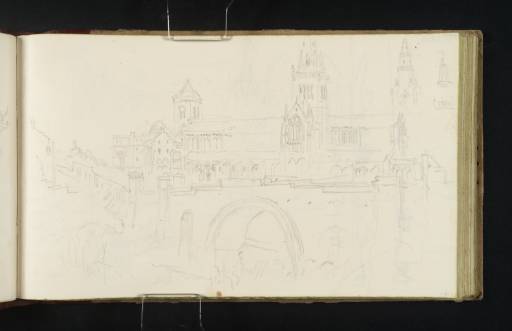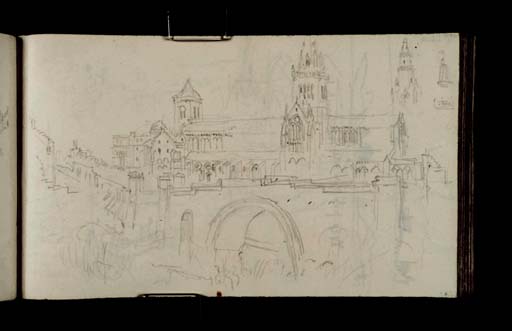Joseph Mallord William Turner Glasgow Cathedral and the Bridge of Sighs 1834
Image 1 of 2
Joseph Mallord William Turner,
Glasgow Cathedral and the Bridge of Sighs
1834
Joseph Mallord William Turner 1775–1851
Folio 73 Verso:
Glasgow Cathedral and the Bridge of Sighs 1834
D26399
Turner Bequest CCLXIX 73a
Turner Bequest CCLXIX 73a
Pencil on off-white wove paper, 113 x 190 mm
Accepted by the nation as part of the Turner Bequest 1856
References
1909
A.J. Finberg, A Complete Inventory of the Drawings of the Turner Bequest, London 1909, vol.II, p.867, CCLXIX 73a, as ‘Glasgow Cathedral.’.
1990
Dr David Wallace-Hadrill and Janet Carolan, ‘Turner’s Sketches North of Stirling’, Turner Studies: His Art and Epoch 1775 – 1851, Vol.10 No.1, Summer 1990, p.12.
This is Turner’s final, and most finished drawing that he made of Glasgow in 1834. It depicts the cathedral with the Bridge of Sighs in the foreground as seen from Molendinar Burn to the south-east. The bridge, constructed in 1833, still stands although the burn has been covered by a culvert and Wishart Street now runs along its path. Turner therefore stood on the western side of the burn near the Necropolis to make this sketch.
The main subject of this sketch is the cathedral which is here dominated by its central tower and spire. Turner seems to have underestimated the amount of space he would need to draw this, and so, having run out of space at the top of the page, has had to draw the spire again separately to the right. Another study to the right of this shows the top of the spire in more detail. At the left of the building (the west end) is another, lower tower and steeple which no longer stands. The cathedral is depicted in considerable detail, especially notable in the spire, the window of the southern transept, and the buttresses at the lower level. Turner did economise a little in the sketch, however, drawing only the first three sets of windows along the nave at the left, and the first few along the choir to the right of the tower. Behind the cathedral to the left is part of the Royal Infirmary, which is recognisable by its dome.
As David Wallace-Hadrill has pointed out,1 the cathedral, Molendinar Burn and what was to become the Necropolis are all described in Sir Walter Scott’s novel, Rob Roy (1817):
Situated in a populous and considerable town, this ancient and massive pile has the appearance of the most sequestered solitude. High walls divide it from the buildings of the city on one side; on the other, it is bounded by a ravine, at the bottom of which, and invisible to the eye, murmurs a wandering rivulet, adding, by its gentle noise, to the imposing solemnity of the scene. On the opposite side of the ravine rises a steep bank, covered with fir-trees closely planted, whose dusky shade extends itself over the cemetery with an appropriate and gloomy effect.2
Turner’s 1834 tour of Scotland was undertaken to collect views to illustrate a number of works by Sir Walter Scott, including a new edition of the so-called Waverley Novels. Glasgow’s connection to Rob Roy is therefore likely to have been the reason for Turner’s visit, explaining his focus on the cathedral and the surrounding area. The viewpoint of this sketch suggests that Turner was either familiar with this passage in the novel, or had been advised, presumably by Scott’s publisher Robert Cadell, to seek out this particular view.3 Not included in this sketch, but seen on folios 71 and 71 verso (D26394, D26395) is the old Barony Church (no longer extant).
Further sketches of Glasgow with the cathedral are on folios 69–71 verso (D26390–D26395). There is also a sketch of Trongate in Glasgow on folio 60 (D26372). The sketch on folio 69 verso (D26391) is very similar to the present view, though it is less developed as a drawing.
Thomas Ardill
October 2010
Although Turner did not complete any designs for Robert Cadell’s ‘Abbotsford edition’ of the Waverley Novels, the Rob Roy edition was nevertheless illustrated with an engraving of Glasgow Cathedral by John Horsburgh after Clarkson Stanfield (Turner’s replacement after the pulled out of the commission). Walter Scott, Waverley Novels [Abbotsford edition], vol.3, Edinburgh 1843, frontispiece.
How to cite
Thomas Ardill, ‘Glasgow Cathedral and the Bridge of Sighs 1834 by Joseph Mallord William Turner’, catalogue entry, October 2010, in David Blayney Brown (ed.), J.M.W. Turner: Sketchbooks, Drawings and Watercolours, Tate Research Publication, December 2012, https://www


